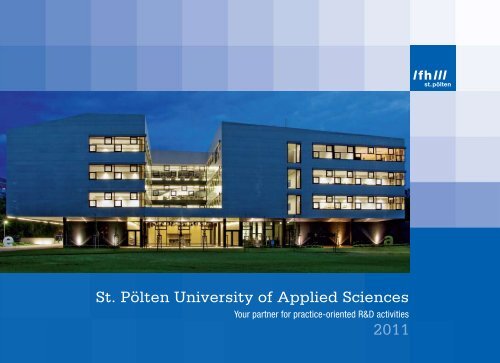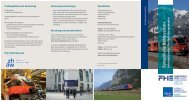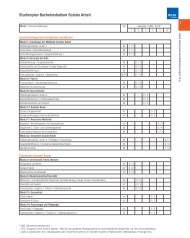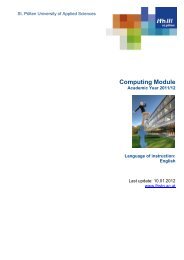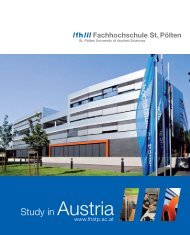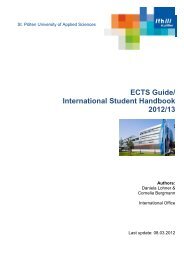2011 St. Pölten University of Applied Sciences - Fachhochschule St ...
2011 St. Pölten University of Applied Sciences - Fachhochschule St ...
2011 St. Pölten University of Applied Sciences - Fachhochschule St ...
You also want an ePaper? Increase the reach of your titles
YUMPU automatically turns print PDFs into web optimized ePapers that Google loves.
<strong>St</strong>. <strong>Pölten</strong> <strong>University</strong> <strong>of</strong> <strong>Applied</strong> <strong>Sciences</strong><br />
Your partner for practice-oriented R&D activities<br />
<strong>2011</strong>
R&D at the <strong>St</strong>. <strong>Pölten</strong> <strong>University</strong> <strong>of</strong> <strong>Applied</strong> <strong>Sciences</strong><br />
In the last few years, the <strong>St</strong>. <strong>Pölten</strong> <strong>University</strong> <strong>of</strong> <strong>Applied</strong> <strong>Sciences</strong> (<strong>Fachhochschule</strong><br />
<strong>St</strong>. <strong>Pölten</strong>) has successfully intensified its research and development activities, featuring<br />
internationally recognized top expertise and laboratory equipment. These areas will<br />
continue to be the focus <strong>of</strong> much energy in the future.<br />
The <strong>St</strong>. <strong>Pölten</strong> <strong>University</strong> <strong>of</strong> <strong>Applied</strong> <strong>Sciences</strong><br />
emphasizes broad cooperation and scientific<br />
networking with national and international<br />
partner organizations. The early involvement<br />
<strong>of</strong> the students in research projects with<br />
enterprises is important to the <strong>St</strong>. <strong>Pölten</strong><br />
<strong>University</strong> <strong>of</strong> <strong>Applied</strong> <strong>Sciences</strong>, enabling young<br />
scientists to gather experience. The state-<strong>of</strong>the-art<br />
infrastructure, featuring labs, a radio<br />
and TV studio, and audio rooms, provides the<br />
optimal premises for interdisciplinary research<br />
projects.<br />
In accordance with the breadth <strong>of</strong> the studies<br />
<strong>of</strong>fered (especially in the departments <strong>of</strong><br />
Technology, Economics, and Health and Social<br />
<strong>St</strong>udies), successful work has been carried out<br />
in the development <strong>of</strong> studies-related applied<br />
research competence and the construction<br />
<strong>of</strong> long-lasting Research, Development and<br />
Innovation (RDI) capacity.<br />
This brochure <strong>of</strong>fers you insight into current<br />
projects <strong>of</strong> the research areas <strong>of</strong><br />
n Simulation and<br />
n Railway Transport<br />
as well as the<br />
n Institute <strong>of</strong> Creative \ Media / Technologies,<br />
n Institute for Research in IT Security,<br />
n Institute <strong>of</strong> Media Economics,<br />
n Institute for Health <strong>Sciences</strong>,<br />
n Ilse Arlt Institute for Research on<br />
Social Inclusion.<br />
The <strong>St</strong>. <strong>Pölten</strong> <strong>University</strong> <strong>of</strong> <strong>Applied</strong> <strong>Sciences</strong><br />
looks forward to working on projects with you,<br />
and warmly invites you to participate.<br />
For more information on the R&D projects,<br />
please go to: www.fhstp.ac.at/forschung/projekte/<br />
Contact<br />
<strong>St</strong>. <strong>Pölten</strong> <strong>University</strong> <strong>of</strong> <strong>Applied</strong> <strong>Sciences</strong>, Matthias Corvinus-<strong>St</strong>raße 15, A-3100 <strong>St</strong>. <strong>Pölten</strong><br />
T: +43/2742/313 228, F: +43/2742/313 228 - 339, E: research@fhstp.ac.at<br />
I: www.fhstp.ac.at/forschung
R&D projects<br />
http://www.fhstp.ac.at/forschung/institute_bereiche/<br />
simulation/unsereprojekte<br />
http://www.fhstp.ac.at/forschung/institute_bereiche/<br />
simulation/unsereprojekte<br />
Tunable Micr<strong>of</strong>luidic Chips for Isolating Circulating Cancer Cells<br />
Together with project partners from the areas<br />
<strong>of</strong> cancer research, magnetic nanotechnology<br />
and blood cleansing, the Simulation Team<br />
has developed a prototype for a kind <strong>of</strong> sieve<br />
to catch circulating tumor cells. The analysis<br />
<strong>of</strong> circulating tumor cells using lab-on-chip<br />
technology opens up new possibilities. For<br />
example, the growth <strong>of</strong> a tumor and the success<br />
<strong>of</strong> a treatment both can be observed. Compared<br />
with current micr<strong>of</strong>luidic chips, the advantage<br />
<strong>of</strong> this method is in the option to adjust the<br />
microstructure <strong>of</strong> the chip in such a way as to<br />
maximize both its capacity and its sensitivity to<br />
the cells <strong>of</strong> a certain type <strong>of</strong> cancer. A tuneable<br />
chip can be used for cancer research and for<br />
the clinical treatment <strong>of</strong> cancer in the areas <strong>of</strong><br />
detection, diagnosis and monitoring.<br />
Expensive rare earths are a necessary<br />
component <strong>of</strong> high-performance magnets. Their<br />
usage for this purpose can be optimized and<br />
thus reduced.<br />
In joint research projects with the <strong>University</strong><br />
<strong>of</strong> California, Davis (USA) and the <strong>University</strong><br />
<strong>of</strong> Sheffield (UK), computer models are<br />
being developed and employed for materials<br />
development to compensate for the projected<br />
shortage in rare metals and rare earths. Within<br />
these projects, the intention is to optimize highperformance<br />
magnets for hybrid cars.<br />
The <strong>St</strong>. <strong>Pölten</strong> <strong>University</strong> <strong>of</strong> <strong>Applied</strong> <strong>Sciences</strong><br />
is a national research partner in the Vienna<br />
Computational Materials Laboratory (ViCoM),<br />
a collaborative research center for the<br />
development and application <strong>of</strong> computer-aided<br />
Project Management at the <strong>St</strong>. Poelten <strong>University</strong> <strong>of</strong> <strong>Applied</strong><br />
<strong>Sciences</strong><br />
FH-Pr<strong>of</strong>. Univ. Pr<strong>of</strong>. DI Dr. Thomas Schrefl,<br />
Research Area Simulation,<br />
E: thomas.schrefl@fhstp.ac.at<br />
Duration<br />
July 2010 – June 2012<br />
Project partners<br />
Austrian Institute <strong>of</strong> Technology, Health &<br />
Environment Department<br />
Danube <strong>University</strong> Krems, Center for<br />
Biomedical Technology<br />
Federal Clinical Center Krems, Hematological-<br />
Oncological Services<br />
Financing<br />
Life Science Krems GmbH<br />
Rare Earths – Simulation to Optimize the Use <strong>of</strong> Expensive Basic Materials<br />
methods to calculate the physical and chemical<br />
qualities <strong>of</strong> materials as precisely as possible.<br />
Within the Multiscale Simulations <strong>of</strong> Magnetic<br />
Nanostructures project, the <strong>St</strong>. <strong>Pölten</strong> <strong>University</strong><br />
<strong>of</strong> <strong>Applied</strong> <strong>Sciences</strong> is using funding from the<br />
Austrian Science Fund to develop fast methods<br />
for calculating magnetic interactions.<br />
Project Management<br />
FH-Pr<strong>of</strong>. Univ. Pr<strong>of</strong>. DI Dr. Thomas Schrefl,<br />
Research Area Simulation,<br />
E: thomas.schrefl@fhstp.ac.at
R&D projects<br />
http://www.fhstp.ac.at/forschung/institute_bereiche/<br />
kompetenzfeld-schienenverkehr<br />
http://neviset.fhstp.ac.at<br />
Simulation <strong>of</strong> Electric Heating <strong>of</strong> Direct Current Overhead Contact Systems<br />
In short-range public transportation, direct<br />
current is frequently used for powering engines.<br />
In comparison with standard railways, the<br />
power supply and the output that is transferred<br />
are both lower. Additionally, the increased<br />
use <strong>of</strong> electronics makes the vehicles prone<br />
to frequent malfunctions. Ice can easily form<br />
where sections <strong>of</strong> track are exposed. These<br />
same sections can also suffer from insufficient<br />
power supply, which compounds the effects <strong>of</strong><br />
the ice. Keeping direct current railways ice-free<br />
is therefore an important goal.<br />
Targets: Keeping overhead contact systems icefree<br />
using electricity is especially suitable for<br />
long sections <strong>of</strong> track, as within a short time, they<br />
can be de-iced with little personnel expenditure.<br />
A widely-used variant, which, however, has<br />
operational disadvantages, is de-icing using<br />
NeVisET – New Visions <strong>of</strong> Emerging Technologies<br />
The research project NeVisET is dedicated to<br />
the problem that currently, in the A/V area,<br />
media presence is an important factor for<br />
success, while at the same time there is a lack<br />
<strong>of</strong> TV programs featuring science, research<br />
and technology communication, especially for<br />
adolescent viewers.<br />
Targets: The project is therefore developing an<br />
audio and video media program for science and<br />
technology communication for an adolescent<br />
audience, while especially considering gender<br />
aspects. A key goal is the reprocessing and<br />
practical utilization <strong>of</strong> current theoretical<br />
foundations in the areas <strong>of</strong> gender, target group<br />
analysis and format development for media<br />
production. The added value <strong>of</strong> this research<br />
project thus consists <strong>of</strong> the practical testing<br />
targeted short circuits. A third method uses<br />
pulsed switches to limit the heat current. This<br />
variant is to be researched, compared with the<br />
short circuit method, and its usage simulated<br />
using a real network. The results will lead to<br />
conclusions about its applicability, operational<br />
effects, and benefit.<br />
Project Management/<strong>St</strong>. Poelten <strong>University</strong> <strong>of</strong> <strong>Applied</strong> <strong>Sciences</strong><br />
DI Dr. Christian Fabian, Railway Transport<br />
Team, E: christian.fabian@fhstp.ac.at<br />
Duration<br />
March <strong>2011</strong> – current<br />
Project partner<br />
Andreas Randacher, Salzburg AG, (Traffic<br />
Division)<br />
Financing<br />
Salzburg AG, (Traffic Division)<br />
<strong>of</strong> current theories in the process <strong>of</strong> prototype<br />
development <strong>of</strong> an audio-visual media program<br />
for science and technology communication for an<br />
adolescent target group, as well as the prototype<br />
production <strong>of</strong> three pilot broadcasts.<br />
Project Management<br />
FH-Pr<strong>of</strong>. DI Hannes Raffaseder, Institute <strong>of</strong><br />
Creative \ Media / Technologies,<br />
E: hannes.raffaseder@fhstp.ac.at<br />
Duration<br />
September 2009 – December <strong>2011</strong><br />
Financing<br />
Federal Ministry for Transport, Innovation and<br />
Technology in the framework <strong>of</strong> the FEMtech<br />
programme.
R&D projects<br />
http://gemma.fhstp.ac.at<br />
http://icmt.fhstp.ac.at<br />
GeMMA – Generative Music for Media Applications<br />
Choosing suitable media music has become an<br />
increasingly difficult task. One central question<br />
<strong>of</strong> GeMMA (Generative Music for Media<br />
Applications) is how to intelligently transfer to<br />
the applied sector <strong>of</strong> media music the methods<br />
<strong>of</strong> algorithmic and generative composition that<br />
have been developed in the area <strong>of</strong> experimental<br />
new music.<br />
Targets: During the project, a s<strong>of</strong>tware tool is<br />
being developed that will simplify the choice<br />
<strong>of</strong> media music through an optimized user<br />
interface and through targeted, up-to-date<br />
research on the categories, functions and effects<br />
<strong>of</strong> media music. It is still up to the producers<br />
to make important decisions, such as style,<br />
mood, orchestration, etc. Furthermore, (partly)<br />
automatized composing <strong>of</strong> media music is to<br />
be made possible, allowing it to be adapted to<br />
Education that teaches state-<strong>of</strong>-the-art<br />
technology in the area <strong>of</strong> renewable sources <strong>of</strong><br />
energy, energy efficiency and energy systems is<br />
a pedagogical challenge. Especially in the field<br />
<strong>of</strong> renewable energy, it is extremely difficult to<br />
keep conventional teaching materials, such as<br />
books, up to date, as the technology is constantly<br />
changing and being developed further.<br />
Targets: This project aims at compiling additional<br />
didactic teaching and studying material based<br />
on new media in this area for vocational and<br />
similar high schools. In accordance with the<br />
concept <strong>of</strong> blended learning, the students play a<br />
part in the production <strong>of</strong> the teaching material –<br />
film clips, role plays and podcasts – while being<br />
supported by relevant experts.<br />
individual needs without a deep knowledge <strong>of</strong><br />
music theory being required.<br />
Project Management<br />
FH-Pr<strong>of</strong>. DI Hannes Raffaseder, Institute for<br />
Media Production, hannes.raffaseder@fhstp.ac.at<br />
Duration<br />
May 2009 – April 2012<br />
Financing<br />
Federal Ministry for Transport, Innovation and<br />
Technology, Federal Ministry for Economy,<br />
Family and Youth, in the framework <strong>of</strong> the<br />
programme COIN Aufbau.<br />
Clip-it! – New Didactic Media in the Area <strong>of</strong> Renewable Sources <strong>of</strong> Energy and<br />
Energy Efficiency for Vocational and Similar High Schools<br />
Project Management<br />
FH-Pr<strong>of</strong>. DI Hannes Raffaseder, Institute <strong>of</strong><br />
Creative \ Media / Technologies,<br />
E: hannes.raffaseder@fhstp.ac.at<br />
Duration<br />
January <strong>2011</strong> – January 2014<br />
Project partners<br />
energieautark consulting Ltd. (project<br />
management), AEE – Institute for Sustainable<br />
Technologies, Bioenergy 2020+ Ltd.,<br />
Die Wiener Volkshochschulen Ltd.,<br />
Sonnenplatz Großschönau Ltd., TB-Panic<br />
Financing<br />
Climate and energy funds <strong>of</strong> the New Energies<br />
2020 programme
R&D projects<br />
http://icmt.fhstp.ac.at<br />
http://www.fit-fuer-forschung.eu<br />
PITOTI – Digitalization and Presentation <strong>of</strong> Prehistoric Rock Art from Italy<br />
Prehistoric rock engravings are an important<br />
part <strong>of</strong> Europe’s cultural heritage. ‘Pitoti’, as the<br />
figures that our ancestors carved into rock are<br />
called, mainly occur in a high Alpine valley in<br />
Lombardy called Valcamonica, which has been<br />
designated a UNESCO World Cultural Heritage<br />
site. The preservation <strong>of</strong> these art works require<br />
special measures. As rock art is stationary,<br />
it cannot be transported at will. The high<br />
interest in these works <strong>of</strong> art exposes them to<br />
a constant stream <strong>of</strong> visitors, which endangers<br />
and destroys the delicate paintings.<br />
Targets: Archaeologists and media technology<br />
experts from Italy, Austria and England have<br />
been working at preserving the most precious<br />
examples <strong>of</strong> early art. Through state-<strong>of</strong>-the-art<br />
technology, the works <strong>of</strong> art are digitalized, thus<br />
making them permanently accessible to visitors<br />
European Researchers‘ Night <strong>2011</strong><br />
European Researchers’ Night is a coordinated,<br />
Europe-wide event in which researchers and<br />
scientists make their achievements come alive<br />
for the public in one night at around fifty locations<br />
in the member states <strong>of</strong> the EU. This science<br />
night takes place at the <strong>St</strong>. <strong>Pölten</strong> <strong>University</strong><br />
<strong>of</strong> <strong>Applied</strong> <strong>Sciences</strong>, which was selected as<br />
the only location in Austria to participate. The<br />
slogan ‘FIT for research’ embraces research,<br />
art and lifestyle at the <strong>University</strong> <strong>of</strong> <strong>Applied</strong><br />
<strong>Sciences</strong>. In this context, FIT means fitness<br />
as well as focus on research, innovation and<br />
technology The <strong>St</strong>. <strong>Pölten</strong> <strong>University</strong> <strong>of</strong> <strong>Applied</strong><br />
<strong>Sciences</strong> metamorphoses into an intellectual<br />
fitness center where visitors find a wide range<br />
<strong>of</strong> diverse activities for body, mind and soul.<br />
The cooperation <strong>of</strong> the Archeology Museum <strong>of</strong><br />
in exhibitions across the continent in the forms<br />
<strong>of</strong> film, animation and installation.<br />
Project Management/<strong>St</strong>. Poelten <strong>University</strong> <strong>of</strong> <strong>Applied</strong> <strong>Sciences</strong><br />
Dr. Frederick Baker, B.A. (Hons) Sheffield, M.Phil.,<br />
Ph.D. (Cambridge), Institute <strong>of</strong> Creative\ Media /<br />
Technologies, E: frederick.baker@fhstp.ac.at<br />
Duration<br />
May <strong>2011</strong> – April 2013<br />
Project Partners<br />
Centro Camuno di <strong>St</strong>udi Preistorici, Capo di<br />
Ponte, Italy (project management), Museum<br />
<strong>of</strong> Archaeology & Anthropology, <strong>University</strong> <strong>of</strong><br />
Cambridge, UK<br />
Financing<br />
European Commission Culture Programme<br />
(2007–2013)<br />
the world-renowned <strong>University</strong> <strong>of</strong> Cambridge,<br />
the Italian Centro Camuno di <strong>St</strong>udi Preistorici<br />
and the Bauhaus <strong>University</strong> <strong>of</strong> Weimar enables<br />
a confrontation <strong>of</strong> prehistoric worlds with the<br />
virtual cyberspace <strong>of</strong> digital media.<br />
Project Management/<strong>St</strong>. Poelten <strong>University</strong> <strong>of</strong> <strong>Applied</strong> <strong>Sciences</strong><br />
FH-Pr<strong>of</strong>. DI Hannes Raffaseder, Institute <strong>of</strong><br />
Creative \ Media / Technologies<br />
E: hannes.raffaseder@fhstp.ac.at<br />
Duration<br />
April <strong>2011</strong> – October <strong>2011</strong><br />
Project Partners<br />
PR&D GmbH<br />
Financing<br />
7th Research Framework Programme <strong>of</strong> the European<br />
Commission, program FP7-People-<strong>2011</strong>-Night
R&D projects<br />
http://www.fhstp.ac.at/forschung/institute_bereiche/<br />
institutfueritsicherheitsforschung<br />
http://www.fhstp.ac.at/forschung/institute_bereiche/<br />
institutfueritsicherheitsforschung<br />
Face-MOC – Facial Recognition Matching-On-Chip for biometric authentification<br />
with Smart Cards / HW Token<br />
Our information society lives on unmanipulated,<br />
authentic and confidential data. Today, user<br />
authentification is mostly done using passwords<br />
and PINs. In the future, for reasons <strong>of</strong> security,<br />
more and more biometric methods will be used.<br />
And for reasons <strong>of</strong> security and data protection,<br />
the storage and verification <strong>of</strong> biometric data<br />
directly on the chip <strong>of</strong> the smart card will become<br />
more important. For facial recognition, however,<br />
the problem <strong>of</strong> how to make a Matching-On-Chip<br />
(MOC, biometric pattern comparison directly on<br />
the chip <strong>of</strong> a smart card) has not been solved,<br />
mainly because <strong>of</strong> the chip cards‘ limited central<br />
memory and low computational power.<br />
Targets: During the project, a practical MOC<br />
solution for biometric facial recognition with<br />
<strong>St</strong>egIT – Research <strong>of</strong> Anti-<strong>St</strong>eganography Solutions<br />
<strong>St</strong>eganography is the science <strong>of</strong> transmitting and<br />
saving secret information in such a way that an<br />
outsider does not even perceive the existence<br />
<strong>of</strong> this information. Thus, there is great danger<br />
in the area <strong>of</strong> organized crime and industrial<br />
espionage. Due to the increasing distribution<br />
<strong>of</strong> Voice over Internet Protocol (VoIP) and the<br />
‘intelligence’ <strong>of</strong> mobile telephony, a drastic<br />
increase in steganography is to be expected in<br />
the future.<br />
Targets: In the project, concrete procedures<br />
and prototypes for defense against modern<br />
steganographic attacks via Voice over Internet<br />
Protocol (VoIP) are being industrially researched<br />
and developed. So that defensive measures can<br />
be tested and weaknesses can be optimally<br />
identified, this project deals also with concealed<br />
chip cards is to be researched and developed, so<br />
that the user‘s data on the chip <strong>of</strong> his/her smart<br />
card is protected and cannot be read. For saving<br />
the most important innovations, an European<br />
patent was registered.<br />
Project Management<br />
FH-Pr<strong>of</strong>. Univ.-Doz. DI Dr. Ernst Piller, Institute for<br />
Research in IT Security, ernst.piller@fhstp.ac.at<br />
Duration<br />
June 2009 – July <strong>2011</strong><br />
Financing<br />
Federal Ministry for Transport, Innovation and<br />
Technology, Federal Ministry for Economy,<br />
Family and Youth, in the framework <strong>of</strong> the<br />
programme COIN Aufbau<br />
data transmission in VoIP and data storage<br />
using steganographic methods.<br />
The next step is to improve these defense<br />
measures with the so called steg-analyis and<br />
with a safety evaluation.<br />
Project Management<br />
FH-Pr<strong>of</strong>. Univ.-Doz. DI Dr. Ernst Piller, Institute for<br />
Research in IT Security, ernst.piller@fhstp.ac.att<br />
Duration<br />
January 2009 – current<br />
Financing<br />
Federal Ministry for Transport, Innovation and<br />
Technology in the framework <strong>of</strong> the KIRAS PL3<br />
programme.
R&D projects<br />
http://www.fhstp.ac.at/forschung/institute_bereiche/<br />
institutfuermedienwirtschaft<br />
http://www.fhstp.ac.at/forschung/institute_bereiche/<br />
institutfuermedienwirtschaft<br />
IT-induced changes in publishing houses<br />
Increasing digitalization has changed the<br />
structure <strong>of</strong> the products <strong>of</strong> media enterprises,<br />
leading to changes in performance processes and<br />
financing processes as well as in the instruments<br />
for company management. For example, when<br />
content is created at one point and then used<br />
repeatedly in different media, the way that prices<br />
are calculated for that content has to change.<br />
The introduction <strong>of</strong> content management<br />
systems leads to different production processes;<br />
digitalizing products results in altered cost<br />
structures and new requirements for the<br />
calculation <strong>of</strong> cost and pr<strong>of</strong>it.<br />
Target: To identify and systematize changes in<br />
publishing houses and to propose design ideas<br />
for required changes. As a first step, based<br />
on a framework <strong>of</strong> theoretical analysis and<br />
taking into consideration two case studies,<br />
The media industry is characterized by what has<br />
been called a double market: on the one hand,<br />
media products such as newspapers and TV<br />
programs convey information and entertainment<br />
for the recipients, and on the other, they <strong>of</strong>fer<br />
advertisers access to their target groups and<br />
help communicate advertising messages.<br />
Between the advertising customers and the<br />
media enterprises, there are intermediaries<br />
who market spots and time slots for advertising<br />
messages, thus bringing together demanders<br />
(advertising customers) and providers (media<br />
enterprises). In contrast to other countries with<br />
strong media, the Austrian marketers’ market<br />
is not transparent concerning its number <strong>of</strong><br />
research has been conducted to determine<br />
what change processes are triggered when<br />
content management systems are introduced<br />
in pr<strong>of</strong>essional media enterprises – and how<br />
publishing houses deal with them.<br />
Project Management<br />
Priv.-Doz. Dr. Svenja Hagenh<strong>of</strong>f, Institute for<br />
Media Economics, E: svenja.hagenh<strong>of</strong>f@fhstp.ac.at<br />
Duration<br />
June 2010 – current<br />
Project Partners<br />
Deutscher Ärzte-Verlag GmbH, Schlütersche<br />
Verlagsgesellschaft mbH & Co. KG, Verein<br />
Deutsche Fachpresse, Deutsche Post<br />
Verlagsservices<br />
Financing<br />
Project partners and proprietorial financing<br />
Analysis <strong>of</strong> the <strong>St</strong>ructure <strong>of</strong> the Markets for People who Market Advertising Space and<br />
Advertising Time in the Media Categories <strong>of</strong> TV, Radio, Print, Internet, and Posters in Austria<br />
participants and the size <strong>of</strong> the values involved.<br />
This project, therefore, aims at comprehending<br />
and analyzing the structure <strong>of</strong> this market.<br />
Project Management<br />
Mag. (FH) Johanna Grüblbauer, Institute for<br />
Media Economics,<br />
E: johanna.grueblbauer@fhstp.ac.at<br />
Duration<br />
February <strong>2011</strong> – July <strong>2011</strong><br />
Project Partner<br />
Puls 4<br />
Financing<br />
Puls 4
R&D projects<br />
http://www.fhstp.ac.at/forschung/institute_bereiche/<br />
gesundheitswissenschaften<br />
http://www.fhstp.ac.at/fhstp/forschung/institute_bereiche/<br />
gesundheitswissenschaften<br />
<strong>St</strong>. <strong>Pölten</strong> on a Healthy Path<br />
Under the slogan ‘<strong>St</strong>. <strong>Pölten</strong> on a healthy path’,<br />
new trails in the areas <strong>of</strong> health and health<br />
promotion will be explored. In close cooperation<br />
with the city <strong>of</strong> <strong>St</strong>. <strong>Pölten</strong>, the Institute for<br />
Health <strong>Sciences</strong> is establishing projects for<br />
health promotion and preventative medicine for<br />
<strong>St</strong>. <strong>Pölten</strong>’s population, its enterprises and its<br />
institutions. One <strong>of</strong> the targets <strong>of</strong> this project is<br />
to obtain scientifically-based statements about<br />
how heath-promoting behavior on the part <strong>of</strong><br />
individuals can be supported and promoted by<br />
the city government <strong>of</strong> an Austrian state capital.<br />
The multi-dimensional projects essentially aim<br />
at the whole <strong>of</strong> the population, but are <strong>of</strong>fered<br />
on various intervention levels and for specific<br />
target groups.<br />
Diabetes Risk Screening In Adolescents<br />
In a worldwide development, diabetes mellitus<br />
type 2 has been transforming from a disease<br />
<strong>of</strong> the elderly into a disease striking people<br />
in their first half <strong>of</strong> life, and is by far the most<br />
frequent consequence <strong>of</strong> obesity. Today, one<br />
<strong>of</strong> the big challenges in the health sector is the<br />
implementation <strong>of</strong> effective strategies for the<br />
prevention <strong>of</strong> type 2 diabetes in public and private<br />
health care. For this, it is necessary to identify<br />
people with an increased risk for the disease as<br />
early and inexpensively as possible.<br />
Targets: World Diabetes Day (WDD) is an<br />
opportunity to call adolescents‘ attention to<br />
diabetes as a widespread disease. The target <strong>of</strong><br />
the project is to assess the prevalence <strong>of</strong> diabetesthreatened<br />
adolescents in the <strong>St</strong>. Poelten area<br />
while simultaneously directing their attention<br />
Project Management<br />
FH-Pr<strong>of</strong>. Barbara Schmid, MSc, Institute for<br />
Health <strong>Sciences</strong><br />
Duration<br />
January 2010 – December 2012<br />
Project Partner and Financing<br />
Municipal Administration <strong>of</strong> <strong>St</strong>. <strong>Pölten</strong><br />
to preventive possibilities. Furthermore, based<br />
on FINDRISK – Risiko-Fragebogen DIABETES,<br />
a scientifically-based screening tool is to be<br />
developed for adolescents.<br />
Project Management<br />
Daniela Wewerka-Kreimel, MBA, Institute for<br />
Health <strong>Sciences</strong>,<br />
E: daniela.wewerka-kreimel@fhstp.ac.at<br />
Duration<br />
January 2009 – December 2014<br />
Project Partners<br />
Health Administration <strong>of</strong> the City <strong>St</strong>. <strong>Pölten</strong>,<br />
Federal Vocational School <strong>St</strong>. <strong>Pölten</strong>, High<br />
School Englische Fräulein <strong>St</strong>. <strong>Pölten</strong>, as well as<br />
other high schools and vocational schools in<br />
<strong>St</strong>. <strong>Pölten</strong>.
R&D projects<br />
http://www.fhstp.ac.at/studienangebot/bachelor/pt/projekte<br />
http://www.fhstp.ac.at/studienangebot/bachelor/pt/projekte/<br />
music-enhanced-training<br />
Research in Physical Therapy<br />
Researchers from the degree programm<br />
Physiotherapy investigate new types <strong>of</strong> problems<br />
in numerous projects on behalf <strong>of</strong> small and<br />
medium-sized enterprises. A support program<br />
called Innovationsscheck, financed by the Federal<br />
Ministry for Transport, Innovation and Technology<br />
(BMVIT) and the Federal Ministry <strong>of</strong> Economy,<br />
Family and Youth (BMWFJ), facilitates access to<br />
ongoing research and innovation activities for<br />
small and medium-sized businesses.<br />
In a project with Martin Daxböck Ltd., an<br />
innovative and novel health care concept for geriatric<br />
patients who are leg amputees is being developed for<br />
the area <strong>of</strong> central Lower Austria, considering<br />
the quality <strong>of</strong> patient care as well as health<br />
economics.<br />
Based on the problem <strong>of</strong> how to use shoes with<br />
Music Enhanced Training<br />
Especially in cyclical endurance sports such as<br />
running and cycling, asynchronous music can<br />
negatively influence the motion rhythm, thus<br />
possibly resulting in a disadvantage in keeping<br />
up the heart frequency desired. Assuming<br />
that the rhythm <strong>of</strong> the body’s motion can be<br />
actively influenced by the rhythm <strong>of</strong> music, this<br />
interdisciplinary project uses music as a steering<br />
measure in endurance sport.<br />
Target: The concept is to support runners through<br />
the intelligent choice and manipulation <strong>of</strong><br />
music from their private music library during<br />
their training in an individual way, and enable<br />
them to maintain the optimal running speed, as<br />
determined by heartbeat and by a previouslyentered<br />
training target. A music-based feedback<br />
system for mobile phones and smart phones could<br />
unstable soles in the area <strong>of</strong> physical therapy<br />
strength training for the lower extremities, a<br />
scientific concept is being developed on behalf<br />
<strong>of</strong> the physical therapist Roman Erdösi that<br />
explains choices and types <strong>of</strong> strength exercises<br />
using unstable soles.<br />
In a project commissioned by the company<br />
Sport Christian, a concept for science-based training<br />
<strong>of</strong> coordination and balance is being developed and<br />
evaluated, using the balance pad as sports<br />
equipment.<br />
Project Management and Project Team<br />
FH-Pr<strong>of</strong>. Mag. Astrid Figl-Hertlein, PT, degree<br />
programme Physiotherapy,<br />
E: astrid.figl@fhstp.ac.at; Kerstin Lampel, PT,<br />
Romana Bichler, PT, Mag. Brian Horsak<br />
sustainably contribute to motivating people to<br />
become involved in sports, while increasing the<br />
quality <strong>of</strong> each training unit.<br />
Project Management<br />
FH Pr<strong>of</strong>. DI Hannes Raffaseder, Institute <strong>of</strong><br />
Creative\ Media / Technologies<br />
E: hannes.raffaseder@fhstp.ac.at<br />
FH-Pr<strong>of</strong>. Mag. Astrid Figl-Hertlein, PT,<br />
degree programme Physiotherapy,<br />
E: astrid.figl@fhstp.ac.at<br />
Project Partners<br />
Interdisciplinary project <strong>of</strong> the Institute <strong>of</strong><br />
Creative \ Media / Technologies and the degree<br />
programme Physiotherapy
R&D projects<br />
http://www.fhstp.ac.at/forschung/institute_bereiche/<br />
ilsearltinstitut<br />
http://www.fhstp.ac.at/forschung/institute_bereiche/<br />
ilsearltinstitut<br />
Development <strong>of</strong> an Information Platform with Didactic Videos to Support Relatives<br />
<strong>of</strong> the Sick and Elderly as they Give Care<br />
Most people want to be cared for at home in<br />
familiar surroundings. But family members<br />
<strong>of</strong>ten lack sufficient knowledge how to turn care<br />
into the best practice possible. In this context,<br />
forms <strong>of</strong> training supported by information and<br />
communication technology, including didactic<br />
videos, could provide support.<br />
Targets: The aim <strong>of</strong> this pilot project is to develop<br />
a prototype for an information platform. For this,<br />
relevant material has been developed according<br />
to topics chosen, processed with the support<br />
<strong>of</strong> information and communication technology,<br />
and provided on the internet for use. The<br />
didactic videos graphically show special care<br />
methods; users can access them according to<br />
their needs.<br />
Network Empowerment in Labor-Market Projects<br />
The Family Group Conference is a process that<br />
has strongly increased in importance over the<br />
last few years. Developed in New Zealand to<br />
help services planning and decision-making in<br />
situations where a child’s welfare is in jeopardy,<br />
it has spread to other countries and social work<br />
fields. The focus <strong>of</strong> this process is on developing<br />
solutions in a gathering <strong>of</strong> the extended family.<br />
This activates the resources <strong>of</strong> the social network<br />
and prioritizes autonomy and participation. The<br />
best practice examples so far demonstrate the<br />
success and sustainability <strong>of</strong> the process.<br />
Targets: To improve the integration <strong>of</strong> individuals<br />
outside the labor market into their first<br />
employment and to support networking. This<br />
project is intended to be evaluated and its<br />
procedure adapted in a feasability study for use<br />
Project Management<br />
FH Pr<strong>of</strong>. DI Hannes Raffaseder, Institute <strong>of</strong><br />
Creative\ Media / Technologies<br />
E: hannes.raffaseder@fhstp.ac.at<br />
FH-Pr<strong>of</strong>. Dr. Tom Schmid, Ilse Arlt Institute for<br />
Research on Social Inclusion,<br />
E: tom.schmid@fhstp.ac.at<br />
Duration<br />
July <strong>2011</strong> – April 2012<br />
Projekt partner<br />
Interdisciplinary project between the Ilse Arlt<br />
Institute for Research on Social Inclusion, and the<br />
Institute for Media Production<br />
Financing<br />
Lower Austrian <strong>St</strong>ate Academy<br />
in a labor-market context, targeting recipients<br />
<strong>of</strong> need-oriented guaranteed minimum income.<br />
Furthermore, a training concept is to be<br />
developed and tried in a pilot project.<br />
Project Management<br />
FH-Pr<strong>of</strong>. DSA Mag. (FH) Christine Haselbacher,<br />
Ilse Arlt Institute for Research on Social Inclusion,<br />
E: christine.haselbacher@fhstp.ac.at<br />
Duration<br />
June <strong>2011</strong> – March 2013<br />
Project Partner<br />
Office <strong>of</strong> the Lower Austrian <strong>St</strong>ate Government<br />
Financing<br />
Federal Ministry <strong>of</strong> Labor, Social Affairs and<br />
Consumer Protection (BMASK) and European<br />
Social Fund (ESF)
<strong>St</strong>. Poelten <strong>University</strong> <strong>of</strong> <strong>Applied</strong> <strong>Sciences</strong><br />
Matthias Corvinus-<strong>St</strong>raße 15, A-3100 <strong>St</strong>. <strong>Pölten</strong><br />
T: +43/2742/313 228, F: +43/2742/313 228 - 339<br />
E: <strong>of</strong>fice@fhstp.ac.at, I: www.fhstp.ac.at<br />
Photos: Foto-Kraus, FH Archiv, Rita Newman, Fotostudio Vodicka


